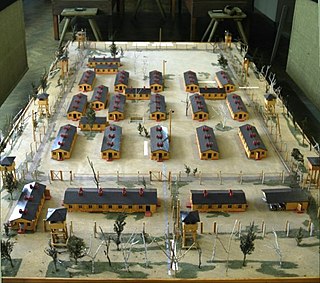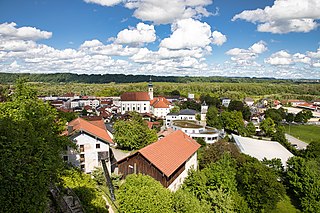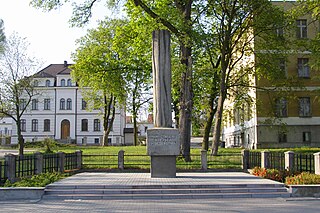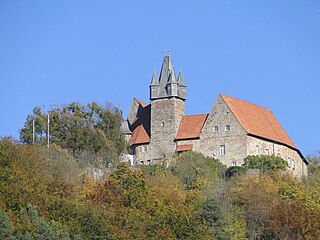
In Germany, stalag was a term used for prisoner-of-war camps. Stalag is a contraction of "Stammlager", itself short for Kriegsgefangenen-Mannschaftsstammlager, literally "main camp for enlisted prisoners of war". Therefore, "stalag" technically means "main camp".

Laufen is a town in Berchtesgadener Land district in Bavaria at the Austria–Germany border.

Tittmoning is a town in the district of Traunstein, in Bavaria, Germany.
Oflag VII-B was a World War II German prisoner-of-war camp for officers (Offizierlager), located in Eichstätt, Bavaria, about 100 km (62 mi) north of Munich.

Stalag VII-A was the largest prisoner-of-war camp in Nazi Germany during World War II, located just north of the town of Moosburg in southern Bavaria. The camp covered an area of 35 hectares. It served also as a transit camp through which prisoners, including officers, were processed on their way to other camps. At some time during the war, prisoners from every nation fighting against Germany passed through it. At the time of its liberation on 29 April 1945, there were 76,248 prisoners in the main camp and 40,000 or more in Arbeitskommando working in factories, repairing railroads or on farms.

Oflag IV-C, generally known as Colditz Castle, was a prominent German Army prisoner-of-war camp for captured Allied officers during World War II. Located in Colditz, Saxony, the camp operated within the medieval Colditz Castle, which overlooks the town. The word "Oflag" is an abbreviation of the German term Offizierslager, meaning "officers' camp." The camp held officers who were deemed escape risks or who had already attempted escape from other prison camps. Known for its seemingly impenetrable structure, Colditz Castle became a site of numerous escape attempts, some of which were successful, earning a reputation for the ingenuity and daring of its prisoners. The camp's history and the elaborate escape plans conceived there have been widely covered in postwar memoirs, books, and media. Today, Colditz Castle has become a popular tourist destination, with guided tours, exhibitions and a museum dedicated to the prisoners' life.

Stalag XVIII-A was a World War II German Army (Wehrmacht) prisoner-of-war camp located to the south of the town of Wolfsberg, in the southern Austrian state of Carinthia, then a part of Nazi Germany. A sub-camp Stalag XVIII-A/Z was later opened in Spittal an der Drau about 100 km (62 mi) to the west.

Oflag VII-C was a World War II German prisoner-of-war camp for officers located in Laufen Castle, in Laufen in south-eastern Bavaria from 1940 to 1942. Most of the prisoners were British officers captured during the Battle of France in 1940. To relieve overcrowding, some of the officers were transferred to Oflag VII-C/Z in Tittmoning Castle. The Oflag existed only for a short time. In early 1942 all the officers were transferred to Oflag VII-B in Eichstätt.
Oflag V-B was a World War II German prisoner-of-war camp for officers (Offizierlager), in operation from 1940 until 1942. It was located in Biberach in south-eastern Baden-Württemberg.
Ilag is an abbreviation of the German word Internierungslager. They were internment camps established by the German Army in World War II to hold Allied civilians, caught in areas that were occupied by the German Army. They included United States citizens caught in Europe by surprise when war was declared in December 1941 and citizens of the British Commonwealth caught in areas engulfed by the Blitzkrieg.
Stalag XIII-D Nürnberg Langwasser was a German Army World War II prisoner-of-war camp built on what had been the Nazi party rally grounds in Nuremberg, northern Bavaria.

Oflag 64 was a World War II German prisoner-of-war camp for officers located at Szubin a few miles south of Bydgoszcz, in Pomorze, Poland, which at that time was occupied by Nazi Germany. It was probably the only German POW camp set up exclusively for U.S. Army ground component officers. At most other camps there were several nationalities, although they were usually separated into national compounds.

Peter Conder, OBE was a British ornithologist and conservationist known predominantly for his contribution as Director of the Royal Society for the Protection of Birds.
John Robert Edward Hamilton-Baillie MC, was a British Royal Engineers officer famed for numerous escapes from German prisoner of war camps during World War II. During his later life he was a founder of the Fortress Study Group, a prominent member of the Concrete Society, and a dedicated fund raiser for the Red Cross.

Oflag IX-A was a World War II German prisoner-of-war camp located in Spangenberg Castle in the small town of Spangenberg in northeastern Hesse, Germany.

Stalag XXI-D was a German World War II prisoner-of-war camp based in Poznań in German-occupied Poland, operated in 1940–1945. It held Polish, French, British, Belgian, Dutch, Serbian, Soviet and Italian POWs.

Laufen Castle is a square-shaped castle overlooking the Salzach river that was built for the Archbishop of Salzburg in the 15th century. The castle is located in the town of Laufen in the German state of Bavaria. During the Second World War, it was the site of Oflag VII-C, and later of Ilag VII.
John George Lingshaw was a British collaborator who worked in Germany on Nazi propaganda during World War II. In 1946, he was convicted of offences under the Defence Regulations and sentenced to five years penal servitude.

On direct instructions from Adolf Hitler, Nazi German forces deported and interned 2,300 Channel Islands civilian residents. The stated reason was retaliation for internment of German citizens in Persia by the British Government.

Nazi Germany operated around 1,000 prisoner-of-war camps during World War II (1939-1945).














